Dec 15, 2025
Dec 15, 2025
Plant Love and Symbolism - 2
Continued from Part LXI
In the previous part, it was explained how Hinduism has not only endorsed but also proactively engaged in the welfare, protection and preservation of all living beings including animals and plants in the universe since the ancient times. In fact, besides living beings, it has dealt with same way even many non-living things which are associated and useful in some way with the human life on planet. In the process, many of these living and non-living things have even been deified by the Hindus. Some of these legendary plants such as Akshay Vat, Kalpavriksha, Parijaat, etc., were briefly dealt accordingly in the previous part. The followers of the other world religions, particularly the Abrahamic ones, often consciously omit to appreciate this aspect of Hinduism simply because they feel that the God has created every other thing for the use and consumption of the faithful.
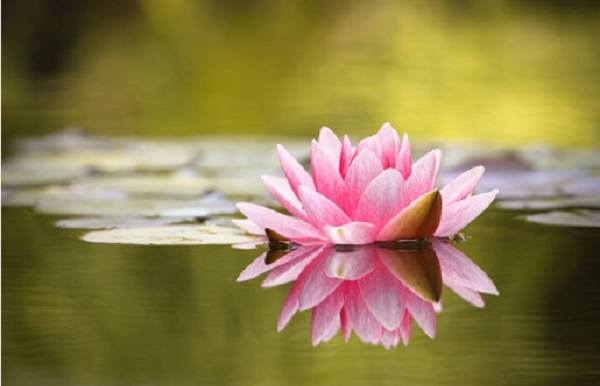
Apart from the legendary plants, India had a tradition of accepting trees and plants with reverence and adoration since Vedic age. We even find references of Vanadevatas and Vanadevis in many ancient texts and the concept is still prevalent in many parts of the rural India. For instance, after Sita was abandoned in the forest by her brother-in-law Lakshman at the instructions of the husband and King Ram, her personal grief and sorrow is said to have deeply moved the plants and trees, which then expressed their grief by shedding flowers symbolic to tear drops. Kalidasa’s Shakuntalam too refers of Vanadevis as her companions in the forest that profusely shed tears at the time of departure from her sylvan home to join her king husband in his palace and gave her gifts of commensurate silken garments and jewellery. In fact, one may find umpteen such moving instances in the ancient Hindu literature which depicts deep human association, love and devotion for the various objects of nature including plants and trees.
Traditionally, many of the plants are also associated with various deities in Hinduism. For instance, few citations from the Vamana Purana about the origin of some plants are given as follows: Lotus (Nelumbo nucifera) from Vishnu’s navel; Banyan (Ficus bengalensis) from Manibhadra, the chief of the Yakshas; Cadamba (Neolamarckia cadamba) from the forepart of the hand of Kandaripa; Datura (Datura fastuosa) from the chest of Shiva; Khadira (Acacia catechu) from the body of Brahma; Kurchi flowers (Jasminium pubescens) from the palm of Parvati; Bamboo (Banduvija pentapates) from Skanda; and Bilva (Aegle marmelos) from Lakshmi. Few more common and well-known plants and trees are briefly described here summarising their taxonomy, special characteristics, cultural significance, common uses for the mankind and associated legends, if any.
1. Banyan Tree

It is of common occurrence with several species abundantly distributed worldwide as Fig trees, which often grow as epiphyte with their seeds germinating in some crack or crevice of the host tree or edifice. However, when we talk about the Indian Banyan tree, it is about the Indian species of Ficus benghalensis, which is a native tree of the Indian sub-continent and is also designated as the national tree of India. The Indian Banyan is one among the largest trees worldwide by its canopy coverage. The tree has a thick and stout trunk, leaves are large, leathery, glossy, elliptical and green, and fruits assume the structure of a syconium. Old banyan trees are characterized by many aerial prop roots that often mature into thick and woody trunks, indistinguishable from the primary stem; such lateral spread of the aerial prop roots allow the tree to proliferate over a wide area.
The banyan tree has many cultural and religious significance in Hinduism. According to a belief, the leaf of the banyan tree is the resting place for the Lord Shree Krishna. There is a long list of prominent banyan trees in India, the most significant being the Great Banyan tree of large tourist attraction located in the Acharya Jagadish Chandra Bose, Indian Botanic Garden, Shibpur, Howrah, near Kolkata. This tree is at least 250 years old and despite its main trunk amputated in 1925 after being struck by cyclones, it has continued to grow beyond a 330-metre road built around its circumference.
Many Hindu scriptures have mentioned the Banyan tree as a Tree of Immortality or Tree of life. In Vishnu Parana, the Nyagrodha (banyan tree) is symbolized with god Vishnu as under:
“As the wide spreading Nyagrodha tree is compressed in a small seed, so at the time of dissolution, the whole universe is comprehended in thee as its germ. As the Nyagrodha germinates from the seed and becomes first a shoot and then rises into loftiness, so the created world proceeds from thee and expands into magnitude”.
As per common belief and practice in Hinduism, the banyan tree planted in front of a temple is either dedicated to Shree Krishna or Shiva and the one planted in other public places to lesser divinities like Yakshas, Kinnaras, Gandharvas etc. The banyan tree is also associated with the god of death, Yama, and many Hindu women worship the tree to please god Yama for the general well-being and long life of their husband and children. Ironically, this tree doesn’t allow a blade of grass under it; hence the tree is not associated with the renewal and fertility ceremonies such as marriage and childbirth.
2. Peepal Tree
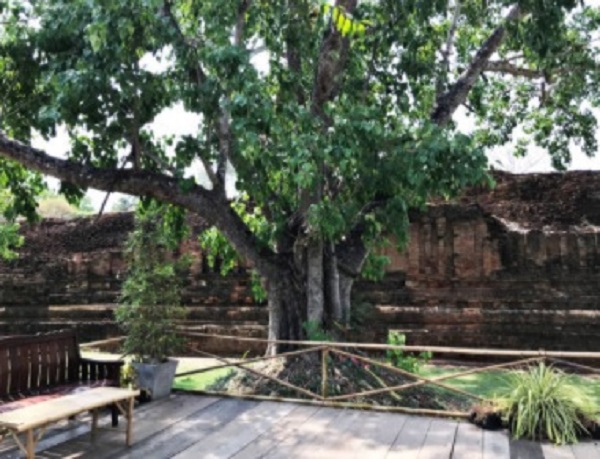
This tree (Ficus religiosa) is native to the Indian sub-continent and is considered a sacred fig tree by the Hindus. It is variously nick-named as the pippala, peepal, ashwattha and Bodhi tree. The peepal tree is a large deciduous or semi-evergreen tree attaining a height upto thirty metres or occasionally even more. The trunk diameter goes upto three metres, leaves are cordate mostly with a distinctly extended drip tip, and fruits are small and green figs becoming purple on ripening. It has unusually long life span ranging from 9-15 hundred years, with the one named Jaya Sri Maha Bodhi, a peepal tree in Sri Lanka estimated to be even more than 2,250 years old. This tree like other fig species is epiphytic, invasive and tolerant to a wide range of climatic conditions. It is also a rich source of traditional medicines with its bark and other parts used in dozens of disorders and diseases like asthma, diabetes, epilepsy, diarrhoea, gastric and inflammatory disorders, infectious and sexual diseases.
The peepal tree has its own cultural and religious significance in three Indian religions, namely Hinduism, Buddhism and Jainism. Ascetics of these religions consider it a sacred tree and so often prefer to meditate under it. Traditionally, many Hindus engage in Pradakshina (circumambulation) around the tree as mark of their reverence and worship reciting "vriksha rajaya namah" (salutation to the king tree). In the Bhagavad Gita (Chapter 15, Verse 1), Shree Krishna spoke of an eternal ashvattha tree with its roots above and branches downwards symbolizing its leaves as the Vedic hymns, and that the one who knows the secret of this tree is the knower of the Vedas. Cultural importance of this tree could be understood from yet another verse (Chapter 10, Verse 26), where Krishna says, “Amongst trees I am the peepul tree; of the celestial sages I am Narad. Amongst the Gandharvas I am Chitrath, and amongst the siddhas I am the sage Kapil”.
Ashvattha is symbolic to the material world which is not constant but ever changing. Terms Sansar and Jagat, used to signify the material world, are derived from the Sanskrit which imply constant change or something which is constantly shifting. In the aforesaid verse, Shree Krishna explained the material world as a huge Ashvattha tree for the soul; roots are originated and nourished by God, branches symbolize various life forms and leaves correspond to Vedic hymns symbolizing rituals and ceremonies. In this way, the leaves of the Ashvattha tree signify nourishment of the material existence of the souls and perpetuate the continuous cycle of life and death. In the context of ascetism, Shiva is also considered as the greatest ascetic of all time and is at times depicted as staying under the shade of peepal tree which is treated as immortal, never dying, never renewing tree.
3. The Ashoka Tree
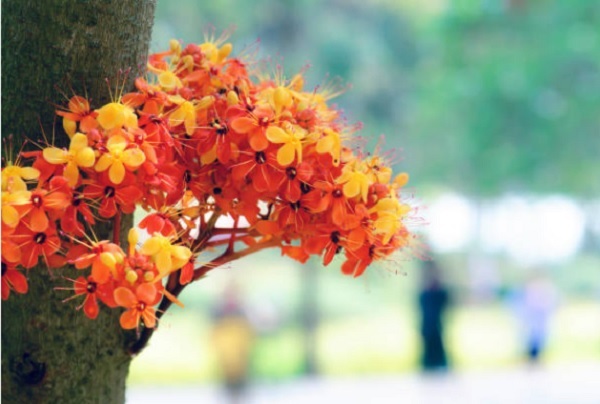
Ashoka implies sorrow-less and this tree (Saraca asoca) is an important plant in the Indian cultural traditions. Although it is widely distributed in the Indian sub-continent, its origin is believed to be of the central parts of the Deccan Plateau although it also grew in abundance in the Western Ghats areas of the sub-continent. The tree is prized for its beautiful foliage and fragrant flowers, which are bright orange-yellow in colour turning red before wilting. Fruits of the Ashoka tree have the appearance of the broad beans having multiple seeds and the bark is used in the cosmetic industry as it is known to be beneficial in improving the skin complexion.
In Hinduism, Ashoka is considered a sacred tree and is associated with many folklores and cultural traditions. The Ashoka tree is worshipped by many Hindu households in the Chaitra month of the Hindu calendar. It is also linked with Kamadeva, the Hindu god of love, who is believed to have included an Ashoka blossom among the five flowers in his quiver, where it represented seductive hypnosis. Its popularity could be counted from the fact that in Sanskrit language at least sixteen different terms have been used to describe the tree or its flowers. It also finds frequent mention in the classical Indian religious and amorous poetry. The Ashoka tree is also associated with the Yakshi, beautiful mythological beings, wherein she is often depicted with her foot on the trunk and hands holding the twig of the flowering Ashoka tree. In the traditional Hindu culture, Yakshi under the Ashoka tree became a popular decorative element particularly displayed at the entrance of Hindu and Buddhist temples.
4. The Kadamba Tree
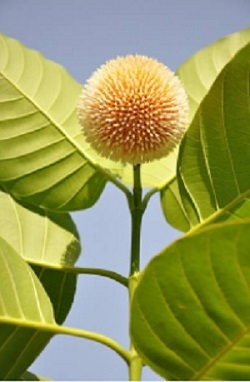 The Kadamba tree (Anthocephalus cadamba) is an evergreen, tropical tree native in the Indian sub-continent and Southeast Asia and is also named as Kadam, Kadamb or Cadamba. It is a large tree that may attain a height upto fourty-five metres with diameter of about one metre. The bark of the tree is grey and smooth when young and rough, and longitudinally fissured in the old trees. The leaves are glossy green, opposite and ovate to elliptical in shape while flowers appear in clusters, orange or yellow in colour and fragrant. The fruits and inflorescences of Kadamba are edible and leaves are fed to cattle. The tree has many uses: The timber has many uses such as for plywood, light construction, pulp and paper, boxes and crates, furniture components, and so on. Its flowers are used as raw material in the attar production in combination with sandalwood and from the root bark yellow dye is prepared. The Kadamba trees are also used for the reforestation programmes and ornamental uses.
The Kadamba tree (Anthocephalus cadamba) is an evergreen, tropical tree native in the Indian sub-continent and Southeast Asia and is also named as Kadam, Kadamb or Cadamba. It is a large tree that may attain a height upto fourty-five metres with diameter of about one metre. The bark of the tree is grey and smooth when young and rough, and longitudinally fissured in the old trees. The leaves are glossy green, opposite and ovate to elliptical in shape while flowers appear in clusters, orange or yellow in colour and fragrant. The fruits and inflorescences of Kadamba are edible and leaves are fed to cattle. The tree has many uses: The timber has many uses such as for plywood, light construction, pulp and paper, boxes and crates, furniture components, and so on. Its flowers are used as raw material in the attar production in combination with sandalwood and from the root bark yellow dye is prepared. The Kadamba trees are also used for the reforestation programmes and ornamental uses.
The tree has a lot of cultural and religious significance attached to it. It has been mentioned in the Bhagavata Purana linking it with Shree Krishna. According to a legend, the love story of Radha and Krishna grew in the hospitable and sweet-scented shade of a Kadamba tree. According to another legendary tale from the life of Shree Krishna, he stole the garments of bathing gopis in Vrindavan and hid them on the branches of the Kadamba tree to teach the latter a lesson so that they avoid bathing nude in public places in future. This episode is found portrayed in many ancient and contemporary arts, paintings and artifacts in the backdrop of the Kadamba tree. In the ancient Hindu texts of the Southern India, it is known as Parvati’s tree with several verses found in praise of goddess Devi (Parvati) who is supposed to dwell in the Kadamba forest. Many more legendary tales are associated with the Kadamba tree, which include a story of Shiva and Parvati, and their child’s birth under a Kadamba tree and another episode of Dhruv’s penance under the Kadamba tree to please god Vishnu.
5. The Lotus Plant

The Indian lotus (Nelumbo nucifera) or “Kamal” is much venerated and considered as sacred plant in Hinduism since ancient times for its cultural significance and multiple uses. It is an aquatic plant, colloquially also known as the water lily, is adapted to grow in the flood plains of slow-moving rivers and deltas as also cultivated in the abundant water gardens for its edible seeds and other uses. It is also the national flower of India. Fresh lotus seeds are nutritious but prone to microbial contamination; hence mostly dry lotus seed-based products are commercially used. The young lotus stems are soft and spongy often used as salad; stalks are often consumed as “kamal gatte ki sabji” in the northern and eastern Indian states; in southern states, stems are sliced, marinated, dried and fried to use as side dish. Similarly, petals, leaves, rhizomes and flowers too are put in various uses.
Lotus plant has cultural and religious significance not only in Hinduism but also in other Indian religions like Buddhism, Jainism and Sikhism, commonly treated as a symbol of purity and innocence. It is linked with several deities and usually reckoned as the seat of goddess Saraswati, goddess Lakshmi, god Vishnu and god Brahma, more particularly with the latter divinity. For the same reason, the lotus flowers are often used as offerings in Indian temples. In Hindu iconography, the divinities Vishnu and Lakshmi are often portrayed in standing position on the pink lotus; similarly, many deities are depicted sitting on the lotus throne. One name of Vishnu is Padmnabha, wherein he is shown in reclining position with lotus arising from his naval and Brahma sitting on it.
The lotus is also the symbol of immortality and divine perfection. God Vishnu is also described as the Pundarikaksha (Lotus-Eyed One). The unfolding petals of lotus suggest the expansion of the soul and its benign and pure beauty despite its origin from the mud suggesting the spiritual growth. It has been extensively and metaphorically used to describe spiritual purity in many Vedic and Puranic literature. One such citation from Srimad Bhagavad Gita (Chapter 5, Verse 10) is reproduced here:
Brahmanyadhaya karmani sangam tyaktva karoti yah,
Lipyate na sa papena padma-patram ivambhasa.
(Those who dedicate their actions to God, abandoning all attachment, remain untouched by sin, just as the lotus leaf is untouched by muddy water.)
6. The Jackfruit Tree
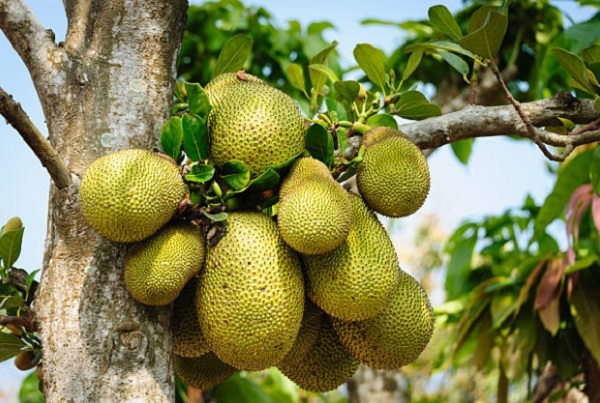
The jackfruit (Artocarpus heterophyllus) is a fig species and is also known as the jack tree. Though its origin is traced to the Western Ghats of Southern India but it is extensively found in all over India and other Southasean countries. Among all trees, the Jack fruits are the largest weighing as much as fifty kilograms in some cases with as much 90 cm in length and 50 cm in diameter. Both ripe and unripe fruits are consumed in various ways by making variety dishes, including custards and cakes. The jackfruit tree is an evergreen tree attaining a height upto twenty metre with numerous branches and dense treetop. The bark of the tree is reddish-brown and smooth, and in the event of an injury, it exudes a milky juice. The seeds of the ripe fruits are also edible with a milky, sweet taste.
Culturally, the Sacred Jackfruit Tree is a historical site in the Indian north-eastern hill state of Manipur where the tree grown on the small hill of Kaina was used to carve images of Lord Shree Krishna. According to a legend, Rajarshi Bhagya Chandra, the King of Manipur in the 18th century, had received instructions in his dream from Krishna to carve His images from this tree. Therefore, seven images of Krishna were carved out from the said jackfruit tree and installed in the various temples of Manipur and the neighbouring state of Assam. Shree Govindajee is one such famous temple located at Imphal, the capital of Manipur. As per the folklore, King Bhagya Chandra had lost his kingdom at the hands of the then Burmese king, took asylum in the neighbouring Assam, had to undergo tough and trying times but with the blessing of Krishna, he was ultimately able to win back his kingdom.
7. Rudraksha

Rudraksha is a seed used as a prayer bead in various sects and denominations of Hinduism, more particularly in Shaivism. It is actually a Sanskrit term, in which “Rudra” symbolizes god Shiva and “aksa” means teardrops i.e., Lord Rudra’s teardrops. These seeds are produced by many species of large, evergreen, broad-leaved Rudraksha tree (Elaeocarpus ganitrus). Besides its religious association with Hindu deities, especially god Shiva, these seeds also have ornamental value being in abundant used in jewellery and malas treated at par with the semi-precious stones. Many devotees of Shiva wear Rudraksha beads for protection and for the regular chanting of the mantra “Om Namah Shivaya”. In Hinduism, different meanings and interpretations are attributed to the Rudraksha beads with varying numbers of segments or the locules of seed (mukh), and some uncommon or unique beads are highly placed in terms of value and effect.
In India, the Rudraksha trees grow from the Gangetic plain in the foothills of the Himalayas to Nepal and attain upto a height of 60 to 80 feet. It is an evergreen tree with its leaves resembling to those of the tamarind or nux vomica but are little longer. On average, a tree yields one to two thousand fruits annually which are popularly known as Amritphala. A soiled Rudraksh bead takes around one year to sprout to a new sapling and the tree starts yielding fruits from three to four years of its germination. There is a tradition of wearing malas of 108 beads among the Hindus, who also use it as rosaries for the meditation and japa to sanctify the body, mind and soul. In these malas, often one extra bead is used which is known as the Meru, principal bead or guru bead that assist in marking the beginning and end of the japa cycle of 108.
8. The Vaijayanti Flower
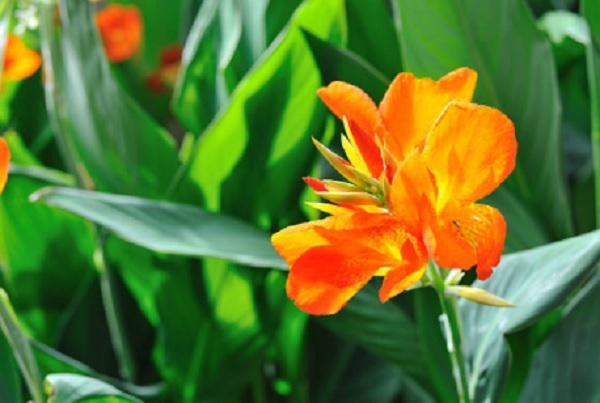
The Vaijayanti or Vana-mala is a theological flower, primarily dedicated to god Vishnu and Shree Krishna (in incarnation of the former) but is offered to other gods too. Vaijayanti-mala, literally meaning the garland of victory, is often worn by these divinities. Vaijayanti is a common name of the flower officially known as Canna Lily. The species have large and attractive foliage, with bright coloured flowers in many hues like red, yellow, orange or combination of these colours. Therefore, many horticulturists grow it in abundance as a garden flowering plant. Although the wild species of the plant grow to a height of two to three metres, a wide variation in its size exists among the cultivated plants. The Cannas species are also rich source of starch for the human and animal consumption; hence many agriculturists exploit its potential in farming.
9. The Banana Tree
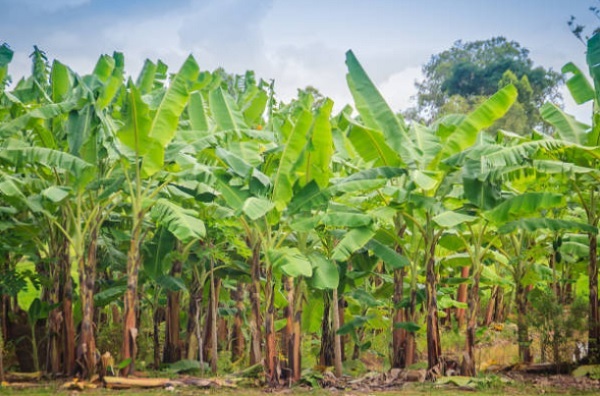
The banana fruit is one of the most popular fruits worldwide, which is very beneficial to health for its nutritional values. In Hinduism, the banana plant and its various parts/products are considered auspicious in many religious and social ceremonies. The banana plant belongs to genus Musa and is perhaps the largest herbaceous flowering plant. The plant is usually tall and sturdy, giving the impression of a tree despite its herbaceous nature and nearly all parts have one or the other uses for the human beings. For instance, the trunk of banana plant is used at the entrance for welcoming guests in religious and social ceremonies. The banana leaves are large, flexible, and waterproof, which are naturally used for serving food in many South Indian restaurants and other establishments in addition to their regular use as eco-friendly disposable plates and containers. The banana hearts and raw fruits are used as a vegetable (curry and fried food).
In Hindu Mythology, there is an interesting story about the origin of the banana tree. Rishi Durvasa was famous for his easily irritable and angry personality. Once he was taking rest when his wife interrupted his sleep due to some dire necessity. He was very upset with wife and instantly cursed her to turn into a banana tree. Later she pleaded with her husband about her good intention and wished that she should be treated special as a holy plant. Rishi Durvasa fulfilled her wish and ever since, the leaves of banana trees are considered auspicious and sacred in Hindu culture. In ancient Hindu texts, the banana tree is mentioned as equivalent to Devaguru Brihaspati. Banana is considered a favourite plant of Lord Ganesha too. In many Tamil weddings, the banana trees are tied in pairs to form an arch as symbol of blessings for a long-lasting and useful life of the couple.
10. The Sandalwood Tree
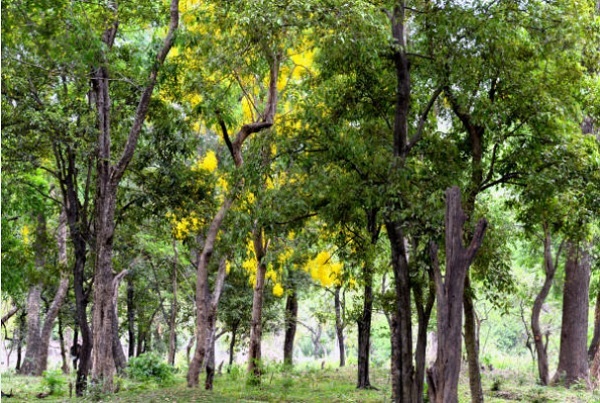
Sandalwood is a special class of fragrant woods from several species belonging to the genus Santalum; the common Indian sandalwood tree being Santalum album. In Sanskrit, it is called Chandana, a favourite of many divinities for its fragrance. These woods are heavy, yellow or yellow-whitish and fine-grained, and are able to retain their fragrance for decades. Also sandalwood is among the most expensive woods in the world and both the wood and oil are prized products of the tree. The Indian sandalwood is a threatened species, indigenous to South India and widely grown in the Western Ghats and few other mountain ranges like Kalrayan and Shevaroy Hills. Though its ownership and harvest is government-controlled, many trees are illegally cut and traded by the thieves and smugglers.
The Indian sandalwood has its own cultural and religious significance. It’s wood is used for worshipping god Shiva and in many other religious ceremonies. Some Hindu texts associate sandalwood with goddess Lakshmi too, who is believed to be very fond of it; hence even uses sandalwood tree as her abode. The Sandalwood has been highly regarded in the Vedic texts too, and its paste and oil are important in worship of gods. The Chandana paste is applied on the forehead of gods and of the worshipers alike. The application of paste on the forehead is believed to calm the mind through the meditation and prayer. Sandalwood oil is also used in incense sticks employed in worship of gods as well as offered in the sacred Yajna fires.
11. Mango Tree
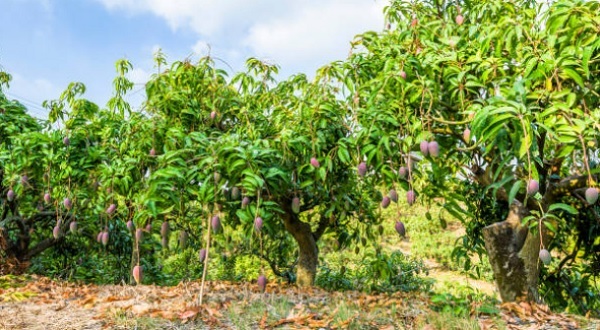
Mango (Magnifera indica) is yet another tree which is considered sacred in Hinduism and finds mention in the Indian Epics and Puranas. Traditionally, the mango is said to be king of all fruits and many Hindus consider it a symbol of love and fertility. As several hybrid varieties are now produced by the cultivators at the commercial scale, its size and varieties considerably vary but a natural mango tree could grow to the height of 30 to 40 metres with the crown radius upto 15 metres or more. The Leaves are evergreen, simple and alternate; although when young, they may be pink, orange or a combination thereof but assume the usual aforesaid characteristic as they mature. The raw fruits are green but the ripe ones vary in size, shape, colour, taste (sweet) and quality. India continues to be world’s largest mango producer with China being the second largest source.
As the king of all fruits, the mango tree is native to the Indian sub-continent. Traditionally, it has ingrained cultural significance in Hinduism treating it a sacred and auspicious tree. The mango is said to be a favourite of god Ganesha and goddess Lakshmi. The fruits are considered a symbol of prosperity, wealth, fertility and knowledge since ancient times. The mango leaves hold religious significance in worship and auspicious ceremonies as they denote the presence of goddess Lakshmi and ward off the negative energy. Besides, they are also used in decoration of the archways and doors of the Hindu households during the weddings and religious festivals such as Ganesha Chaturthi. The mango blossoms are engaged in the worship of the goddess Saraswati. Mango motifs and paisleys are used in various Indian embroidery styles, including Kanchipuram and silk sarees, and Kashmiri shawls.
12. The Bael Tree
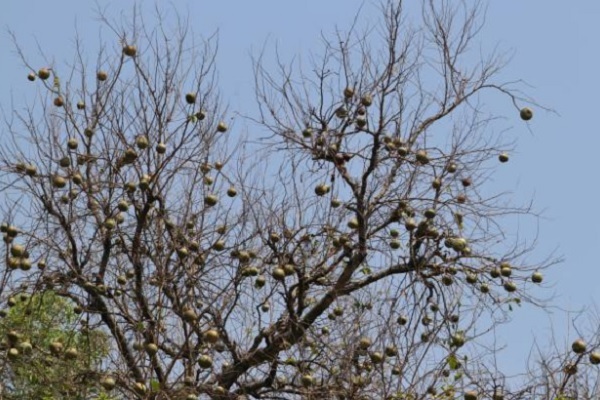
In Hinduism, the Bael tree (Aegle marmelos), also known as bilva or bel, is considered sacred due to its association with god Shiva. The tree is native to the Indian sub-continent, which is a medium sized tree attaining a height upto 13-14 metres with rather drooping branches, and open and irregular crown. The bark of the tree is pale brown or greyish, smooth or even finely fissured with long and straight spines. The leaves are pale green and pinkish when young but become dark green and smooth, trifoliate and alternate on attaining maturity. The bael fruits have a diameter upto 5 to 12 centimetre, globose or little pear-shaped with a thick and hard rind that does not easily split even on ripening. The ripe fruits can be eaten fresh, consumed as drink or dried to convert into candy, toffee, nectar and pulp powder. Various parts of the tree including leaves, bark, roots, fruits and seeds are used in traditional medicine to cure various ailments and diseases.
Bael is considered as a sacred tree by the Hindus and its leaves and fruits are offered to god Shiva on auspicious occasions. The cultural and religious significance of the bael tree is derived from many ancient Hindu texts. Apart from its association with Shiva, this plant is also mentioned as the abode of the goddess Lakshmi, who is the deity of the wealth and prosperity. In a legendary tale, the bael tree is described as the incarnation of the goddess Sati. Bael trees are often found near the Hindu temples due to common belief of Shiva’s fondness to its leaves and fruit. In Nepal and adjacent parts of India, the bael tree is associated with a fertility ritual wherein the young girls are married to the bael fruit in a ceremony. The common belief is that as long as the fruit is intact and safe, the girl cannot be widowed, even if her mortal husband dies.
Few More Sacred Plants
The aforesaid description of sacred plants in Hinduism is only illustrative and by no means inclusive. Actual list of culturally important and pious plants and trees is rather much long. In essence, every vegetation which has been useful for the mankind in someway has been acknowledged in ancient Hindu literature and has one or more legendary or mythological tales attached with it to highlight its significance. A few such more plants are mentioned in the following lines:
Conclusion
A closer look at the civilizational attributes of the contemporary and bygone era world over suggests that the Sanatana Dharma (Hinduism) has remained the only unique culture and religion through all ages, which has eternally acknowledged with sincere gratitude the role and contribution of the animate and inanimate objects of the nature in human life. All others, sans modern environmentalists, have done this either out of the fear or simply treated them as consumables created by the God for the faithful. For instance, the erstwhile civilizations of Greek, Roman or Egypt did many things out of fear and own safety sake while the particular contemporary Abrahamic religion uses natural objects as the gift of God to the faithful. This deep understanding and gratitude of the ancient Hindus towards all beneficial animate and inanimate things of nature has continued even during the modern age.
Continued to Part LXIII
Images (c) istock.com
11-Apr-2021
More by : Dr. Jaipal Singh